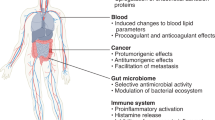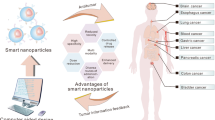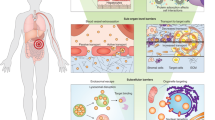Abstract
Nanomaterials with precise biological functions have considerable potential for use in biomedical applications. Here we investigate whether multivalent attachment of small molecules can increase specific binding affinity and reveal new biological properties of such nanomaterials. We describe the parallel synthesis of a library comprising 146 nanoparticles decorated with different synthetic small molecules. Using fluorescent magnetic nanoparticles, we rapidly screened the library against different cell lines and discovered a series of nanoparticles with high specificity for endothelial cells, activated human macrophages or pancreatic cancer cells. Hits from the last-mentioned screen were shown to target pancreatic cancer in vivo. The method and described materials could facilitate development of functional nanomaterials for applications such as differentiating cell lines, detecting distinct cellular states and targeting specific cell types.
This is a preview of subscription content, access via your institution
Access options
Subscribe to this journal
Receive 12 print issues and online access
$209.00 per year
only $17.42 per issue
Buy this article
- Purchase on Springer Link
- Instant access to full article PDF
Prices may be subject to local taxes which are calculated during checkout






Similar content being viewed by others
References
Whitesides, G.M. The 'right' size in nanobiotechnology. Nat. Biotechnol. 21, 1161–1165 (2003).
Nam, J.M., Thaxton, C.S. & Mirkin, C.A. Nanoparticle-based bio-bar codes for the ultrasensitive detection of proteins. Science 301, 1884–1886 (2003).
Tsapis, N., Bennett, D., Jackson, B., Weitz, D.A. & Edwards, D.A. Trojan particles: large porous carriers of nanoparticles for drug delivery. Proc. Natl. Acad. Sci. USA 99, 12001–12005 (2002).
Gao, X. & Nie, S. Molecular profiling of single cells and tissue specimens with quantum dots. Trends Biotechnol. 21, 371–373 (2003).
Zorov, D.B., Kobrinsky, E., Juhaszova, M. & Sollott, S.J. Examining intracellular organelle function using fluorescent probes: from animalcules to quantum dots. Circ. Res. 95, 239–252 (2004).
Santra, S., Yang, H., Holloway, P.H., Stanley, J.T. & Mericle, R.A. Synthesis of water-dispersible fluorescent, radio-opaque, and paramagnetic CdS:Mn/ZnS quantum dots: a multifunctional probe for bioimaging. J. Am. Chem. Soc. 127, 1656–1657 (2005).
Huber, M.M. et al. Fluorescently detectable magnetic resonance imaging agents. Bioconjug. Chem. 9, 242–249 (1998).
Modo, M. et al. Mapping transplanted stem cell migration after a stroke: a serial, in vivo magnetic resonance imaging study. Neuroimage 21, 311–317 (2004).
Josephson, L., Kircher, M.F., Mahmood, U., Tang, Y. & Weissleder, R. Near-infrared fluorescent nanoparticles as combined MR/optical imaging probes. Bioconjug. Chem. 13, 554–560 (2002).
Kircher, M.F., Weissleder, R. & Josephson, L. A dual fluorochrome probe for imaging proteases. Bioconjug. Chem. 15, 242–248 (2004).
Wu, Y., Xiang, J., Yang, C., Lu, W. & Lieber, C.M. Single-crystal metallic nanowires and metal/semiconductor nanowire heterostructures. Nature 430, 61–65 (2004).
Kang, H.W., Josephson, L., Petrovsky, A., Weissleder, R. & Bogdanov, A., Jr. Magnetic resonance imaging of inducible E-selectin expression in human endothelial cell culture. Bioconjug. Chem. 13, 122–127 (2002).
Hogemann, D., Ntziachristos, V., Josephson, L. & Weissleder, R. High throughput magnetic resonance imaging for evaluating targeted nanoparticle probes. Bioconjug. Chem. 13, 116–121 (2002).
Akerman, M.E., Chan, W.C., Laakkonen, P., Bhatia, S.N. & Ruoslahti, E. Nanocrystal targeting in vivo. Proc. Natl. Acad. Sci. USA 99, 12617–12621 (2002).
Kelly, K.A. et al. Detection of vascular adhesion molecule-1 expression using a novel multimodal nanoparticle. Circ. Res. 96, 327–336 (2005).
Harisinghani, M.G. et al. Noninvasive detection of clinically occult lymph-node metastases in prostate cancer. N. Engl. J. Med. 348, 2491–2499 (2003).
Boullier, A. et al. Scavenger receptors, oxidized LDL, and atherosclerosis. Ann. NY Acad. Sci. 947, 214–222, discussion 222–213 (2001).
Denis, M.C., Mahmood, U., Benoist, C., Mathis, D. & Weissleder, R. Imaging inflammation of the pancreatic islets in type 1 diabetes. Proc. Natl. Acad. Sci. USA 101, 12634–12639 (2004).
Libby, P. & Aikawa, M. Stabilization of atherosclerotic plaques: new mechanisms and clinical targets. Nat. Med. 8, 1257–1262 (2002).
Pham, W., Kircher, M.F., Weissleder, R. & Tung, C.H. Enhancing membrane permeability by fatty acylation of oligoarginine peptides. Chem. BioChem. 5, 1148–1151 (2004).
Anderson, D.G., Levenberg, S. & Langer, R. Nanoliter-scale synthesis of arrayed biomaterials and application to human embryonic stem cells. Nat. Biotechnol. 22, 863–866 (2004).
Goodman, C.M., McCusker, C.D., Yilmaz, T. & Rotello, V.M. Toxicity of gold nanoparticles functionalized with cationic and anionic side chains. Bioconjug. Chem. 15, 897–900 (2004).
Mammen, M., Chio, S-K. & Whitesides, G.M. Polyvalent interactions in biological systems: implications for design and use of multivalent ligands and inhibitors. Angew. Chem. Int. Edn Engl. 37, 2755–2794 (1998).
Schreiber, S.L. Target-oriented and diversity-oriented organic synthesis in drug discovery. Science 287, 1964–1969 (2000).
Shen, T., Weissleder, R., Papisov, M., Bogdanov, A., Jr. & Brady, T.J. Monocrystalline iron oxide nanocompounds (MION): physicochemical properties. Magn. Reson. Med. 29, 599–604 (1993).
Wunderbaldinger, P., Josephson, L. & Weissleder, R. Crosslinked iron oxides (CLIO): a new platform for the development of targeted MR contrast agents. Acad. Radiol. (suppl. 2) 9, S304–S306 (2002).
Kelly, K.A., Reynolds, F., Weissleder, R. & Josephson, L. Fluorescein isothiocyanate-hapten immunoassay for determination of peptide-cell interactions. Anal. Biochem. 330, 181–185 (2004).
de Hoon, M.J., Imoto, S., Nolan, J. & Miyano, S. Open source clustering software. Bioinformatics 20, 1453–1454 (2004).
Saldanha, A.J. Java Treeview—extensible visualization of microarray data. Bioinformatics 20, 3246–3248 (2004).
Acknowledgements
The authors would like to acknowledge the help of Fred Reynolds for synthesizing the CLIO-peptide conjugates, Jan Grimm for radiolabelling, Terry O'Loughlin for molecular modeling and nanoparticle characterization and Jose-Luis Figueiredo, Rabi Upadhyay and Gregory Wojtkiewicz for technical assistance.
Author information
Authors and Affiliations
Corresponding author
Ethics declarations
Competing interests
The authors declare no competing financial interests.
Supplementary information
Supplementary Table 1
List of Compounds Conjugated to Nanoparticles (PDF 212 kb)
Rights and permissions
About this article
Cite this article
Weissleder, R., Kelly, K., Sun, E. et al. Cell-specific targeting of nanoparticles by multivalent attachment of small molecules. Nat Biotechnol 23, 1418–1423 (2005). https://doi.org/10.1038/nbt1159
Received:
Accepted:
Published:
Issue Date:
DOI: https://doi.org/10.1038/nbt1159
This article is cited by
-
Concerning the photophysics of fluorophores towards tailored bioimaging compounds: a case study involving S100A9 inflammation markers
Photochemical & Photobiological Sciences (2023)
-
Immunological conversion of solid tumours using a bispecific nanobioconjugate for cancer immunotherapy
Nature Nanotechnology (2022)
-
Recent achievements in sodium alginate-based nanoparticles for targeted drug delivery
Polymer Bulletin (2022)
-
Combination of tumour-infarction therapy and chemotherapy via the co-delivery of doxorubicin and thrombin encapsulated in tumour-targeted nanoparticles
Nature Biomedical Engineering (2020)
-
Current trends and challenges in cancer management and therapy using designer nanomaterials
Nano Convergence (2019)



